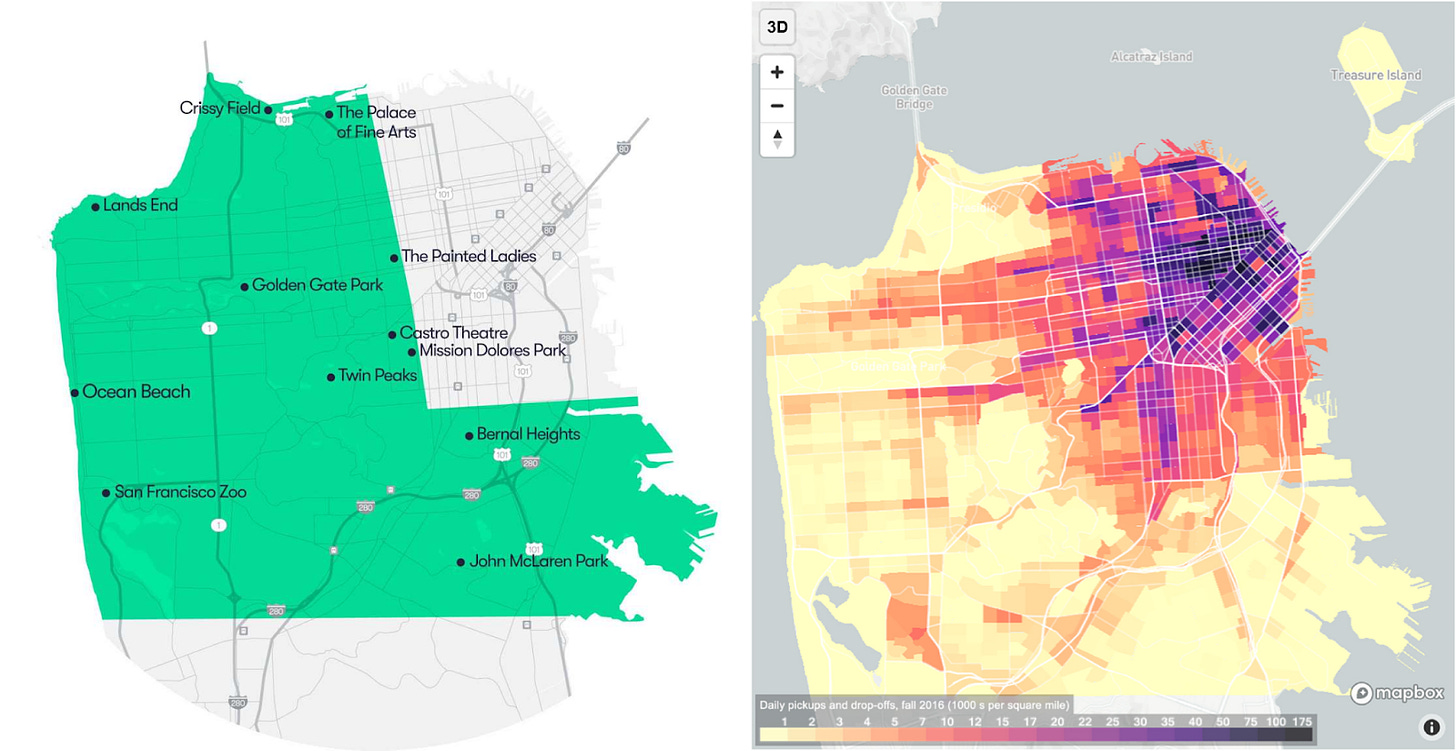This map perfectly explains why Waymo hasn't expanded faster
Waymo is testing driverless rides in San Francisco—but not downtown.
It’s been almost five years since Waymo, Alphabet’s self-driving car company, first announced it was offering rides to ordinary customers in the suburbs of Phoenix. Since then, the company has taken a series of incremental steps toward large-scale commercial deployment:
In December 2018, Waymo announced the launch of a commercial service called Waymo One—albeit with safety drivers behind the wheel.
In October 2020, the company finally launched a fully driverless commercial service—but it remained limited to a small area of the Phoenix suburbs.
In August 2021, Waymo announced that it would start testing its technology with ordinary customers in San Francisco—again, with safety drivers behind the wheel.
On Wednesday, Waymo announced two additional milestones: the start of driverless testing in San Francisco and the expansion of its Phoenix service to include downtown.
The company is making progress, but a lot of people—including me—have wondered why the company hasn’t moved faster.
Waymo has racked up tens of millions of miles on the road with a solid safety record. So why, after nearly five years, hasn't the company expanded to the entirety of the Phoenix metro area? And why isn't Waymo laying groundwork to launch in a dozen other cities, instead of just San Francisco?
An important clue comes from this image created by reddit user declina:
The map on the left depicts Waymo’s San Francisco service area. The map on the right shows the density of Uber and Lyft trips according to a 2017 study. The densest parts of San Francisco, including the city’s downtown, are in the northeastern corner of the map. Unsurprisingly, this is where people take the most Uber and Lyft rides.
If someone were launching a conventional ride-hailing service in San Francisco, you’d expect them to focus first on downtown. Many customers want to travel to or from downtown, so a service that doesn’t serve downtown is at a big disadvantage.
But Waymo is testing a San Francisco service that excludes downtown San Francisco. And it’s not hard to guess why: the densest parts of San Francisco are the hardest for self-driving software to navigate.
Dense urban neighborhoods have a lot of narrow streets, pedestrians, cyclists, construction workers, and so forth. The suburbs of Phoenix, where Waymo started testing in 2017, are at the opposite end of the spectrum. They have wide streets, few pedestrians or cyclists, and sunny weather almost every day.
Back in 2017, Waymo’s strategy made sense to me. I figured that starting in an “easy” area would let the company launch a commercial service earlier, earning some revenue and gaining operational experience as it perfected its software. I expected that by now, Waymo would have spread across the Phoenix metro area, then expanded to other sprawly sun-belt cities like Dallas or Las Vegas.
But almost five years later, Waymo is still only serving a small part of the Phoenix area. Waymo hasn’t explained why. But I suspect a big reason is that the economics of the current service are terrible.
The grim economics of suburban ride-hailing
By definition, suburbs have fewer people—and hence fewer potential customers—per square mile. And almost everyone has a car, so most of those people don't hail a taxi very often. This means vehicles spend a lot of time waiting around, and often have to drive long distances to reach the next customer
“It’s not really a good robotaxi market because personal car ownership is really high here,” said Joel Johnson, a Phoenix-area college student who has taken dozens of Waymo rides.
One reason a suburbanite might hail a taxi is to go to the airport. But Waymo doesn’t offer service to the airport. Johnson tells me that the passenger dropoff area at the main Phoenix airport is “crazy”—perhaps too crazy for Waymo’s software to navigate confidently.
But that leaves Waymo with a dilemma: there isn’t much of a business case for a suburban taxi service that takes people from quiet residential streets to big-box retail stores. Most people making those kinds of trips drive their own cars. But areas with more attractive economics—city centers, airports, college campuses—are the kinds of chaotic, high-density places that are difficult for self-driving cars to navigate.
So with this week’s announcement, Waymo is gingerly taking a step up the difficulty gradient. The company's two new service areas—downtown Phoenix and the lower-density parts of San Francisco—are more challenging than Waymo’s original territory in the Phoenix suburbs. But neither one is as challenging as downtown San Francisco. And ultimately, Waymo will probably need to master such high-difficulty areas to make its service commercially viable.
In recent years, public discourse about self-driving cars has swung wildly from one extreme to the other. Around 2017, many people assumed that self-driving technology would become widely available by 2021. When that didn’t happen, sentiment swung to the opposite extreme. Many folks now think fully driverless technology is decades away.
I think the truth is somewhere in the middle. Waymo and its competitors have continued to make real progress over the last few years. Waymo’s vehicles in Phoenix drive more confidently than they did two or three years ago, and Waymo is gradually tackling more challenging driving situations. The company clearly still has a lot of work to do. But I think a commercially viable service is likely to be years, not decades, away.





